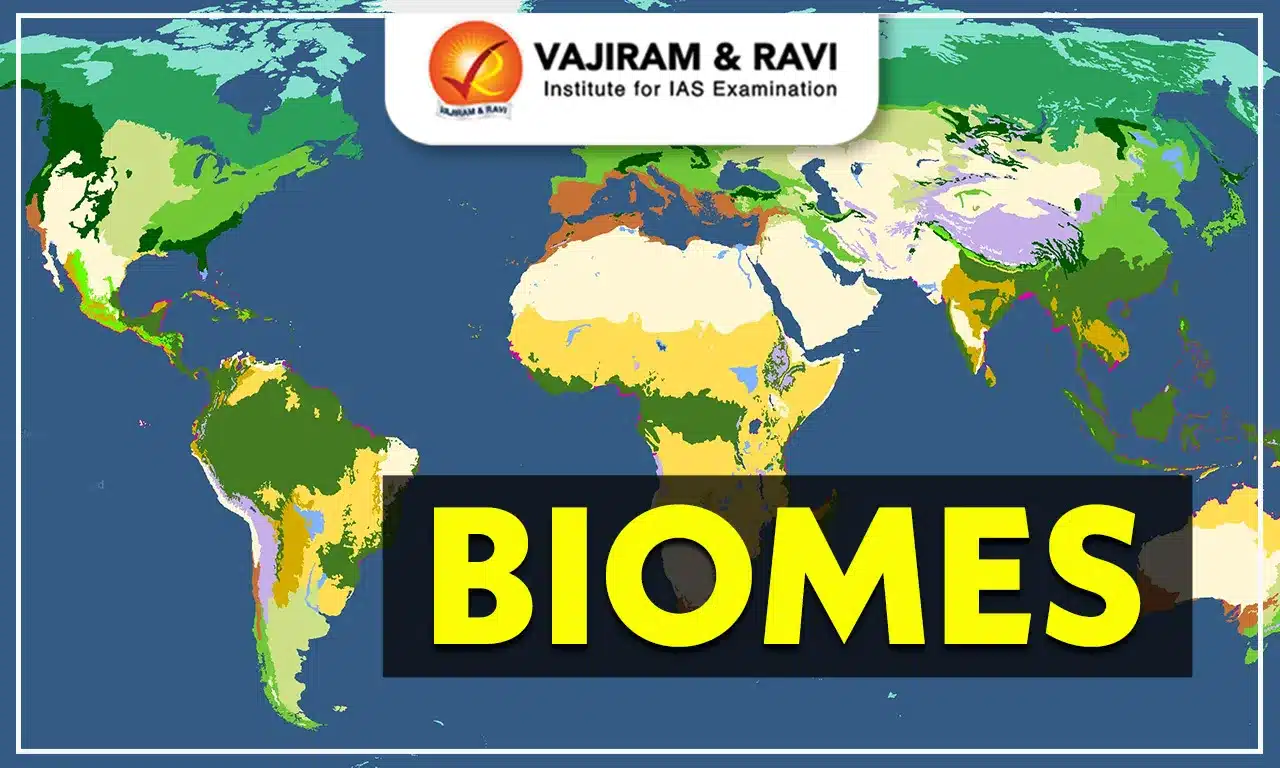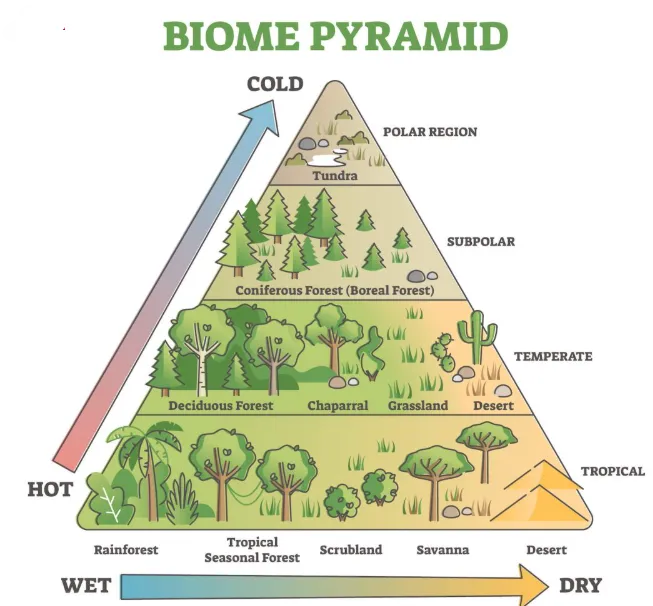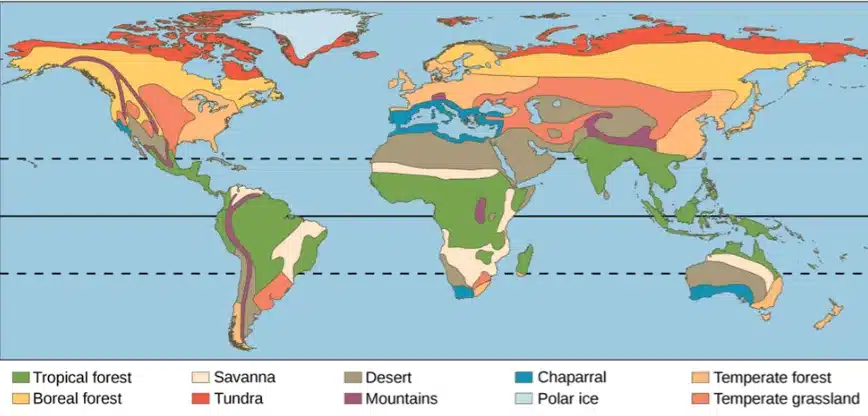
Biomes are vast ecological regions defined by climate, vegetation, and organism adaptations. Their distribution is shaped by factors such as temperature, precipitation, soil, and biological interactions. Classification varies, with models like Whittaker’s temperature-precipitation approach and Walter’s seasonal system highlighting how climate influences global biome patterns and ecosystem resilience.
Broadly grouped as terrestrial and aquatic, biomes include rainforests, deserts, tundras, grasslands, and marine systems. Each has unique vegetation, wildlife, and climatic features, from lush equatorial forests to polar sparsity. In today’s climate crisis, biomes are vital for biodiversity, carbon balance, and human sustenance, but face threats from deforestation, warming, and exploitation.
Biomes Definition
Biomes are vast geographical regions that represent the Earth’s major ecological communities. They are classified primarily on the basis of dominant vegetation and the adaptive features of organisms suited to specific environmental conditions. Key determining factors include:
- Plant structures: Presence of trees, shrubs, or grasses.
- Leaf types: Broadleaf, needleleaf, or other variations.
- Plant spacing: Distribution patterns such as forest, woodland, or savanna.
- Climatic conditions: Temperature, rainfall, and seasonal variations.
Biomes differ globally due to latitude, humidity, sunlight, and topography, supporting unique species. In 2025, amid biodiversity crises, biomes like rainforests are critical for carbon sequestration, as noted in recent IPCC reports.
Factors Influencing Biomes
Biomes' distribution, size, and characteristics are governed by interconnected abiotic and biotic elements, creating varied habitats from equatorial lushness to polar sparsity. These factors dictate energy flows, nutrient cycles, and species resilience.
- Daylight and Darkness Duration: Controls photosynthesis length, vital for plant productivity and food web sustenance.
- Temperature Metrics: Encompass average values and variations (daily and yearly) to gauge harsh conditions that challenge survival.
- Growing Season Extent: Influences vegetation development periods, from perpetual in equatorials to fleeting in polars.
- Precipitation Dynamics: Cover total volume, temporal fluctuations, and strength, determining water availability for flora.
- Wind Patterns: Involve velocity, orientation, persistence, and occurrence, affecting erosion, dispersal, and moisture loss.
- Soil Varieties: Nutrient profiles and compositions impact root systems and microbial ecosystems.
- Slope and Drainage: Topographical inclines and water runoff shape microhabitats and erosion rates.
- Biological Interactions: Coexistence with other species fosters competition, symbiosis, or predation, moulding community structures.

Biomes Classification
Biome classification lacks a universal standard, reflecting diverse scientific perspectives. Some adopt broad classifications that identify as few as five biomes (forest, grassland, freshwater, marine, and desert), while others employ more precise systems listing dozens, including subtypes such as temperate deciduous or tropical savanna. This variability stems from the complexity of environmental factors and the need to balance simplicity with ecological specificity.
Two prominent classification approaches are widely recognised:
- Whittaker’s Model: Developed by Robert Whittaker in 1975, this model utilises a two-dimensional diagram that plots mean annual temperature against annual precipitation. It illustrates transitions between biomes, such as high precipitation and warm temperatures favouring tropical rainforests, while low values lead to deserts or tundras. This quantitative approach helps map global biome distributions effectively.
- Walter’s System: Proposed by Heinrich Walter, this method emphasises seasonality and environmental stress factors like drought and cold. It delineates nine biome types based on seasonal temperature and moisture regimes, offering a dynamic view of how seasonal changes influence vegetation and fauna.
Types of Biomes
Biomes are broadly grouped into terrestrial (land-based) and aquatic (water-based) categories, with terrestrial biomes further divided into tropical, temperate, and tundra zones. Each type exhibits unique characteristics, influenced by factors like temperature, precipitation, soil, and elevation, as detailed below.
Terrestrial Biomes
Terrestrial biomes occupy land areas, shaped by climate and vegetation, and are subdivided into several types based on dominant plant life and environmental adaptations.
Tropical Biomes
Tropical biomes thrive near the equator, characterised by high temperatures, abundant rainfall, and rich biodiversity. They include several distinct subtypes:
- Tropical Evergreen Rainforests:
- Location: Extends up to 10° latitude on both sides of the equator, covering the Amazon lowlands (South America), Congo Basin (Africa), and Southeast Asian islands (Sumatra to New Guinea), as mapped in "Major Biomes of the World."
- Climate: Experiences high temperatures (20-30°C) with a minimal annual range but a higher daily range. Annual rainfall ranges from 150-250 cm, often distributed throughout the year with daily afternoon showers due to high water vapour, creating an equable climate.
- Vegetation: Features three levels—canopy (20-50 m, hardwoods like ebony, mahogany, rosewood, sandalwood), intermediary (10-20 m, palms, epiphytes), and understory (0-10 m, orchids, ferns, mosses). Dense foliage limits sunlight, reducing undergrowth diversity.
- Leaf litter here decomposes rapidly, leaving the forest floor almost bare, while climbers and epiphytes thrive by growing upwards to reach sunlight.
- Animal Life: Hosts numerous birds (macaws, toucans), mammals (jaguars, sloths, orangutans), and aquatic species (alligators, hippos). Most life is arboreal, avoiding the dense lower levels.
- Significance: It represents only 13% of global land but accounts for 40% of total productivity, as noted in "Major Biomes of the World." Current threats include deforestation, which impacts carbon storage.
- Tropical Deciduous Forests (Monsoon Forests):
- Location: Found in regions with pronounced wet and dry seasons, such as India, Southeast Asia, and Central America, as shown in the map from "Major Biomes of the World."
- Climate: Experiences seasonal rainfall (100-200 cm), with trees shedding leaves during the dry period.
- Vegetation: Includes teak, sal, and other deciduous trees arranged in four layers, with less dense undergrowth than evergreens. Trees shed leaves in the dry season to conserve water. Teak is especially dominant in India’s tropical moist deciduous forests.
- Animal Life: Supports elephants, tigers, and deer, adapted to seasonal changes.
- Significance: Vulnerable to agricultural expansion and fires, with notable human impact in India’s sal forests.
- Savanna Biome:
- Location: Predominantly in Africa (e.g., Serengeti), South America, and northern Australia.
- Climate: Hot with seasonal rainfall (50-150 cm), marked by wet and dry periods.
- Vegetation: Dominated by tall grasses with scattered acacia or baobab trees. Forest development here is checked by seasonal rainfall, frequent fires, and grazing by large herbivores.
- Animal Life: Rich in large mammals (lions, elephants, giraffes) and migratory species, as highlighted in "Biomes."
- Significance: A prime grassland example, facing poaching and land conversion threats. Savannas are less rich in biodiversity compared to tropical moist forests, which host the greatest variety of plant and animal life.
- Desert Biome:
- Location: Tropical deserts like the Sahara (Africa) and the Arabian Peninsula.
- Climate: Arid (<25 cm rainfall), with extreme temperature variations (hot days, cold nights).
- Vegetation: Sparse xerophytes (cacti, succulents) with adaptations for water conservation.
- Animal Life: Nocturnal species (camels, lizards) with minimal diversity.
- Significance: Represents arid extremes, with expanding desertification a global concern.
Temperate Biomes
Temperate biomes occur in mid-latitudes, featuring moderate temperatures and distinct seasons, supporting diverse vegetation and wildlife:
- Temperate Deciduous Forests:
- Location: North America (e.g., Great Smoky Mountains), Western Europe (e.g., British Isles).
- Climate: Moderate (0-20°C), with 75-150 cm annual rainfall and four seasons.
- Vegetation: Deciduous trees (oak, maple) that shed leaves in fall, with fertile brown soils.
- Animal Life: Deer, bears, and squirrels, thriving in seasonal cycles.
- Significance: High biodiversity, threatened by invasive species like the emerald ash borer.
- Temperate Evergreen Forests (Coniferous/Taiga):
- Location: Subarctic regions (Canada, Russia).
- Climate: Cold winters (-30°C), short summers (10-20°C), with 30-80 cm precipitation, mostly snow.
- Vegetation: Coniferous trees (spruce, fir) on poor podzol soils due to slow decomposition.
- Animal Life: Moose, wolves, adapted to cold with thick fur.
- Significance: Low productivity, with permafrost thaw releasing methane, a climate concern.
- Temperate Rainforests:
- Location: Pacific Northwest (USA), parts of Chile.
- Climate: Mild, wet winters with 200-400 cm rainfall.
- Vegetation: Tall evergreens (Douglas fir), mosses, lichens.
- Animal Life: Grizzly bears, salamanders.
- Significance: Carbon sinks, vulnerable to logging.
- Temperate Grasslands (Steppe):
- Location: Eurasia (steppes), North America (prairies).
- Climate: Hot summers, cold winters, 25-75 cm rainfall.
- Vegetation: Short grasses, fertile chernozem soils.
- Animal Life: Bison, prairie dogs.
- Significance: Agricultural "granaries" are prone to erosion from overfarming.
- Mediterranean Biome (Chaparral):
- Location: Mediterranean Basin, California, Chile.
- Climate: Hot, dry summers; mild, wet winters (40-100 cm rainfall).
- Vegetation: Shrubs (olive, lavender) with waxy leaves, fire-adapted.
- Animal Life: Coyotes, geckos.
- Significance: Increasing wildfires due to climate drying.
Tundra Biomes
Tundra biomes dominate high-latitude and altitude regions, marked by extreme cold and limited vegetation:
- Arctic Tundra:
- Location: Northern Russia, Canada, Greenland.
- Climate: Extremely cold (-30°C to 10°C), with <25 cm precipitation, mostly snow; permafrost persists.
- Vegetation: Mosses, lichens, sparse grasses on bare rocks.
- Animal Life: Reindeer, arctic foxes, polar bears, with long lifespans (e.g., arctic willow 150-300 years) and thick fur adaptations.
- Significance: Warming causes permafrost melt, releasing methane, amplifying climate change.
- Alpine Tundra:
- Location: High mountain ranges (Himalayas, Alps).
- Climate: Cold due to elevation, with similar precipitation patterns.
- Vegetation: Similar to arctic, with no trees above the treeline.
- Animal Life: Mountain goats, pikas.
- Significance: Mimics arctic conditions, vulnerable to glacial retreat.

Aquatic Biomes
Aquatic biomes encompass water-based ecosystem, covering a significant portion of the Earth’s surface. They are classified into freshwater and marine biomes, each adapted to specific moisture and salinity conditions that shape their biodiversity.
Freshwater Biomes
Freshwater biomes include ecosystems with low salinity levels, such as lakes, rivers, and wetlands. These biomes are characterised by their dependence on precipitation and runoff, supporting unique flora and fauna adapted to minimal salt content.
- Environmental Conditions: Defined by available moisture and temperature, with limited salinity (<0.05%). Latitude, weather, relative humidity, sunlight, and topography influence their distribution.
- Vegetation and Fauna: Support plants like water lilies and animals such as fish and amphibians, thriving in still (lentic) or flowing (lotic) waters.
- Significance: Freshwater biomes are critical for human water supply and biodiversity, though they differ from terrestrial biomes by their aquatic nature. They form part of larger biome systems, interacting with terrestrial ecosystems.
Marine Biomes
Marine biomes consist of saltwater environment, including oceans and coastal zones, characterised by high salinity and vast biodiversity.
- Environmental Conditions: Influenced by moisture and temperature, with salinity typically exceeding 3.5%. They span various latitudes and topographies, from shallow coastal areas to deep oceans.
- Vegetation and Fauna: Host marine plants like seaweed and diverse animals, including fish, corals, and marine mammals, are adapted to saline conditions.
- Significance: Marine biomes are distinct from freshwater biomes due to their salt content and cover a larger global area, playing a key role in global oxygen production and carbon cycling. They are integral to the broader biome classification.
- Some regions, such as the Andaman and Nicobar Islands, are unique for hosting mangrove forests alongside evergreen and deciduous forests, creating highly diverse ecological zones.
Biomes UPSC PYQs
Question 1: The vegetation of savannah consists of grasses with scattered small trees, but extensive areas have no trees. The forest development in such areas is generally kept in check by one or more or a combination of some conditions. Which of the following are such conditions? (UPSC Prelims 2021)
- Burrowing animals and termites
- Fire
- Grazing herbivores
- Seasonal rainfall
- Soil properties
Select the correct answer using the codes given below:
(a) 1 and 2
(b) 4 and 5
(c) 2, 3 and 4
(d) 1, 3 and 5
Answer: (c)
Question 2: “Leaf litter decomposes faster than in any other biome and as a result, the soil surface is often almost bare. Apart from trees, the vegetation is largely composed of plant forms that reach up into the canopy vicariously, by climbing the trees or growing as epiphytes, rooted on the upper branches of trees.” This is most likely the description of: (UPSC Prelims 2021)
(a) Coniferous forest
(b) Dry deciduous forest
(c) Mangrove forest
(d) Tropical rainforest
Answer: (d)
Question 3: The greatest diversity in plants and animals is characteristic of: (UPSC Prelims 2016, 1994)
(a) Temperate deciduous forests
(b) Tropical moist forests
(c) Savanna
(d) Temperate forest with grasslands
Answer: (b)
Question 4: In India, in which one of the following types of forests is teak a dominant tree species? (UPSC Prelims 2015)
(a) Tropical moist deciduous forest
(b) Tropical rainforest
(c) Tropical thorn scrub forest
(d) Temperate forest with grasslands
Answer: (a)
Question 5: Consider the following states:(UPSC Prelims 2015)
(1) Arunachal Pradesh
(2) Himachal Pradesh
(3) Mizoram
In which of the above states do ‘Tropical Wet Evergreen Forests’ occur?
(a) 1 only
(b) 2 and 3 only
(c) 1 and 3 only
(d) 1, 2 and 3
Answer: (c)
Question 6: Which one of the following regions of India has a combination of mangrove forest, evergreen forest, and deciduous forest? (UPSC Prelims 2015)
(a) North Coastal Andhra Pradesh
(b) South-West Bengal
(c) Southern Saurashtra
(d) Andaman and Nicobar Islands
Answer: (d)
